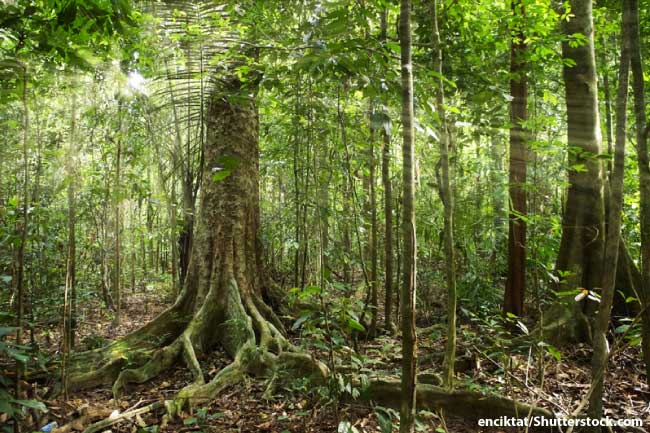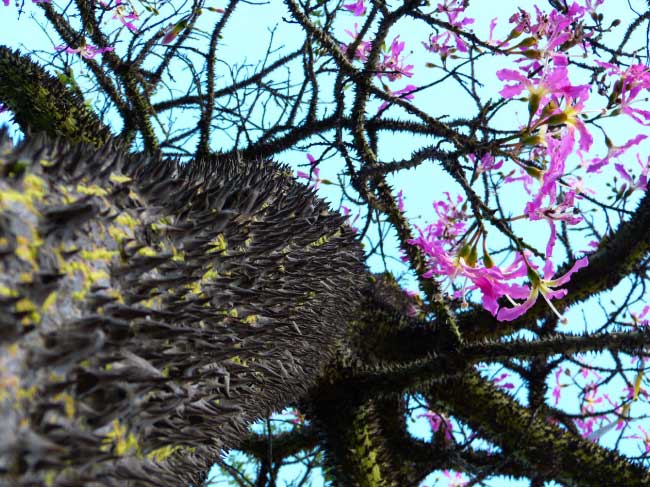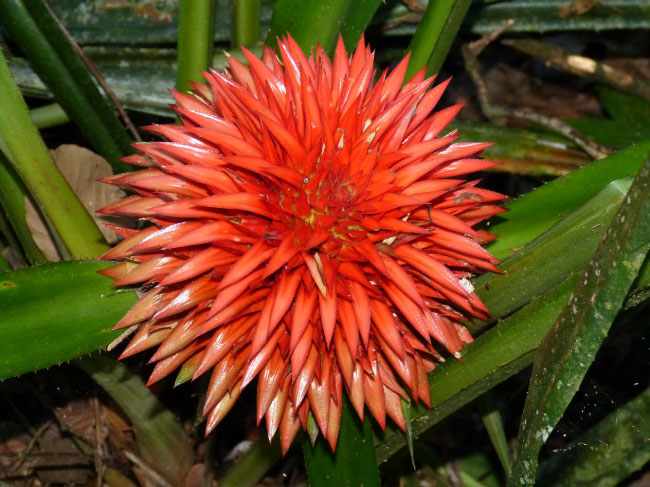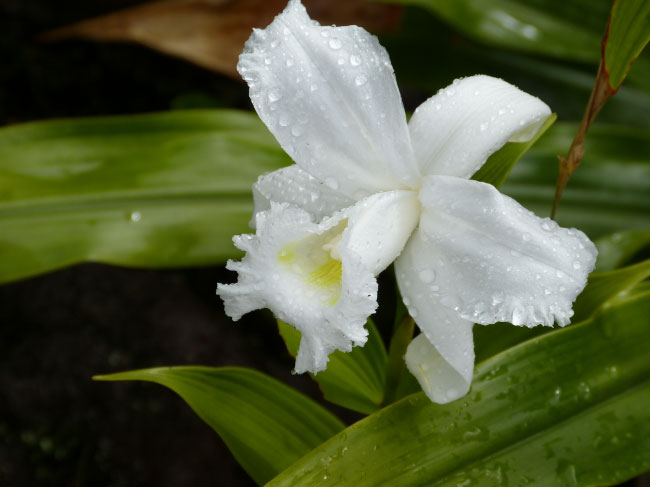On this page we’ll discover some of the plants in the tropical rainforest. You’ll find out what kind of plants live in rainforests, and how they’ve adapted to the rainforest environment. This article is part of our Rainforest series.
This page contains information on rainforest plants, and includes examples of many amazing species.
Don't miss the video of the world's largest flower further down the page!
- You can also see a list of notable rainforest plants here: Rainforest Plants List.
- View a huge list of rainforest animals here: Rainforest Animals List with Pictures & Facts
Plants In The Tropical Rainforest: Introduction
Tropical rainforests, such as the Amazon Rainforest in South America, Daintree Rainforest in Australia, and the Congo Rainforest in Africa, are home to an incredible number of plants.
The Amazon Rainforest itself is home to more than 40,000 plant species!
The most common tree in the Amazon Rainforest is the açai (Euterpe precatoria). However, it only makes up 1% (5 billion) of the 390 billion trees in the region!
Where Do Tropical Rainforests Grow?
Tropical rainforests are found near the equator. The equator is an imaginary line that stretches around the centre of the Earth. Near the equator, the atmosphere is hot and humid. There isn’t much difference between summer and winter. And it rains here. A lot. In tropical regions, more than 2 metres of rain falls every year.
A Constant Battle For Sunlight And Nutrients
Rainforest plants are in a constant battle, not just with the insects, fungi, birds and mammals that eat them, but also with each other.
In order to get the sunlight that they need, plants have to be able to grow faster, or to have bigger leaves, than their neighbours.
Plants protect themselves from predators using various strategies. Some tropical rainforest plants are poisonous, some have thorns, some have thick bark and others have tough leaves.
But it’s not all about keeping animals away. Rainforest plants also have to attract the animals that help them to pollinate. Pollination is the process that starts a new plant growing. 90% of flowering plants require animal assistance to pollinate. (The other 10% use wind or other means to transfer pollen).
One of the plants in the tropical rainforest that has developed a special relationship with an insect is the Bucket Orchid.
Bucket Orchids have co-evolved with Orchid Bees, and neither could exist without the other. The male bees are attracted by the flower’s scent. They collect an oily substance from the flower’s bucket that helps them attract female bees.
However, while collecting the oil, a bee will often fall into the flower’s bucket. The only way out is through a special passage. As the bee makes its way out, pollen is transferred to its body.
The bee is trapped in the orchid long enough for the wax that holds the pollen to the bee’s body to set. The male bee then flies off. Not only will he now be attractive to female bees – if he visits another bucket orchid, he will also pollinate the flower.
Bucket Orchids are found in Central and South America.
Ant Plants
Plants of the genus Cecropia also rely on insect help. These amazing plants actually provide a space in their stems for ants to live in. They also produce special food for the ants. In return, the ants protect the plants from other insect predators.
Characteristics Of Plants In The Tropical Rainforest
Drip Tip Leaves
The leaves of rainforest plants are often waxy, with thin tips, known as ‘drip-tips’. They have evolved this way to encourage rainwater to run off the leaves.
A leaf holding water could become too heavy and break. The water could also encourage fungus and bacteria to grow, which could prevent photosynthesis.
(Photosynthesis is the process by which trees obtain food from sunlight. You can learn about photosynthesis here.)
Buttress Roots
Tropical rainforests often have poor quality soil that is shallow, and low in nutrients.
Because of this, many rainforest trees have developed what are known as ‘buttress roots’.
Buttress roots grow out at an angle from a tree’s trunk up to 10 metres from the ground. They widen the base of the tree, making it more stable in the thin soil. They also help to spread out the tree’s roots over a large area, allowing it to obtain more nutrients.
Kapok trees (Ceiba pentandra) have buttress roots. These tall trees, which can push through the rainforest canopy to form the emergent layer, rely on their wide roots for stability. Kapok trees are found in South American, Asian and African tropical rainforests.
Tropical Rainforest Soil
Rainforest trees often have shallow roots. This is because the few nutrients that are available in the soil are found near the surface. The nutrients come from dead plant material such as decomposing leaves on the forest floor.
Stilt or Prop Roots (Mangroves)
Mangrove forests are tropical forests that grow where the soil is waterlogged for long periods of time. They often occur near the coast.
Some mangrove trees have ‘stilt’ or ‘prop’ roots. These are roots that grow out of the trunk above the ground before extending downwards into the soil. Like buttress roots, they give the trees more stability.
You can see examples of prop roots in a mangrove swamp in the video below:
Trees in mangrove forests also have roots that grow upwards from under the ground. These roots stick out of the mud or water like snorkels. The trees obtain oxygen directly from the air using these ‘root snorkels’.
These roots are also called ‘pneumatophores’.
Types Of Tropical Rainforest Plant
Vines
Lianas are rainforest vines. These thick, woody plants have roots in the ground and wrap themselves around other plants in order to reach the sunlight. Rainforest animas use lianas to climb trees and to get around the upper levels of the tropical rainforest.
Epiphytes
Epiphytes are plants that grow on other plants. Epiphytes are extremely common in tropical rainforests. It is thought that there are over 15,000 species in Central and South American tropical rainforests.
Epiphytes can grow in large numbers without harming the host tree. Over 50 species of epiphyte have been found growing on a single tropical rainforest tree. Together, the epiphytes on a single tree can weigh several tonnes.
Epiphytes include many vines, bromeliads (see below), and orchids.
Epiphytes don’t have their roots in the soil, and cannot obtain water and nutrients like other plants. Epiphytes such as orchids have special spongy roots for obtaining water and particles from the air.
Bromeliads
Bromeliads are a family of flowering plants. Many bromeliads are epiphytes, growing in the canopy of tropical rainforests.
Bromeliads have a tight rosette of spiky leaves. Water is collected in the cylinder formed by the leaves. The water is used not only by the plant itself, but also by many rainforest animals. Poison dart frogs carry their young up into the canopy and leave them in the pools of water formed by the bromeliad’s tightly-wrapped leaves.
Orchids
Orchids are flowering plants which are found all over the world. There are over 27,000 species of orchid. Orchids have three petals and three sepals (sepals are the outer parts of the flower. Orchid stamens often look like extra petals). Orchids have a lower petal that is longer than the others. This acts as a platform for visiting insects.
Many orchids that grow in the tropical rainforest are epiphytes.
The Biggest Rainforest Flower
One of the most amazing plants in the tropical rainforest is the Rafflesia arnoldii. It is only found in the rainforests of Borneo and Sumatra, and is the world’s largest flower. It gives of a smell like rotting flesh, which is why it is also known as the ‘Corpse Flower’.
You can see a video of a Rafflesia below.
Palms
Some of the most useful plants in the tropical rainforest are palms. Palms can be trees, shrubs or vines. They have large leaves and are ‘evergreen’, which means their leaves are green for all of the year.
There are around 2,800 palm species in the world. Most are found in tropical and subtropical regions.
Many rainforest palms (including the acai) are grown for their edible fruit, which are used to flavour fruit drinks and ice cream.
Other notable rainforest palms include the Carnauba Palm (Copernicia prunifera), from which a variety of products, including car polish, surf wax, and lipstick, are made. Rattan palms are used to make furniture.
Uses Of Plants In The Tropical Rainforest
The trees, shrubs, vines and flowers of tropical rainforests provide food and shelter for the animals that live in the forests. They also have a multitude of uses for man.
As we’ve seen, many palm species have uses ranging from building materials to lipstick.
Palms also provide food, mainly in the form of fruit. Many other rainforest plants are harvested for food. The Brazil Nut and Cashew Nut trees are well-known examples.
Rainforest hardwood trees, such as mahogany, are harvested for their wood.
Rainforest plants are used to make medicine, and others are used in cosmetics.
Plants In The Tropical Rainforest Conclusion
We hope that you have enjoyed learning about some of the amazing plants in the tropical rainforest.
See a list of amazing rainforest plants here.
You can find out more about rainforests at our main rainforest page.











